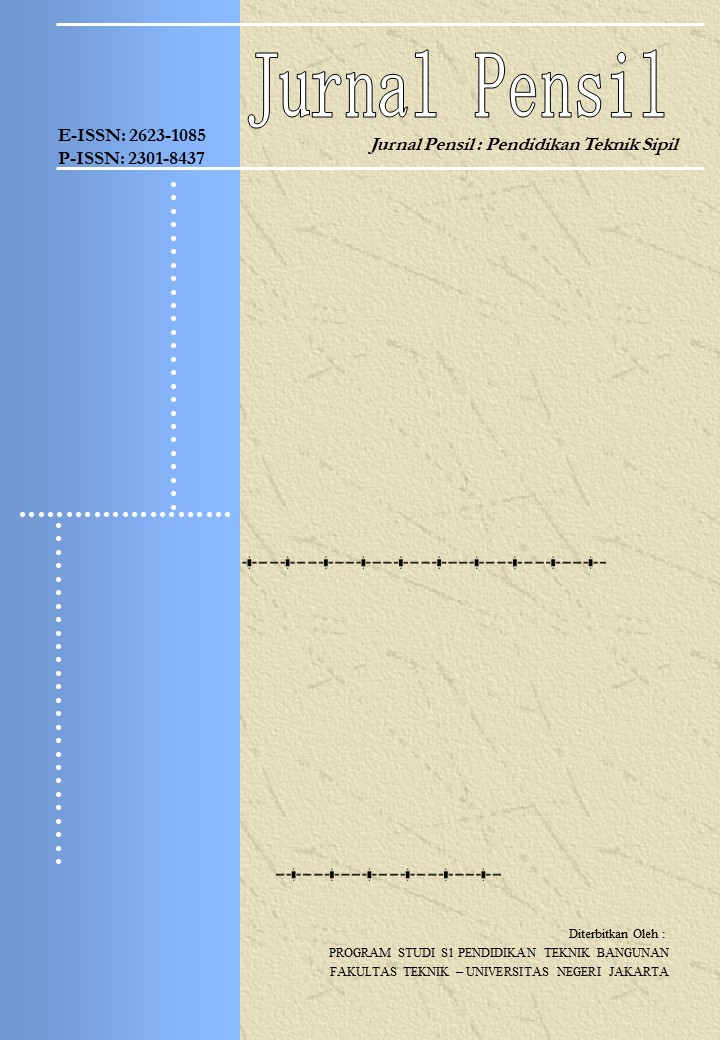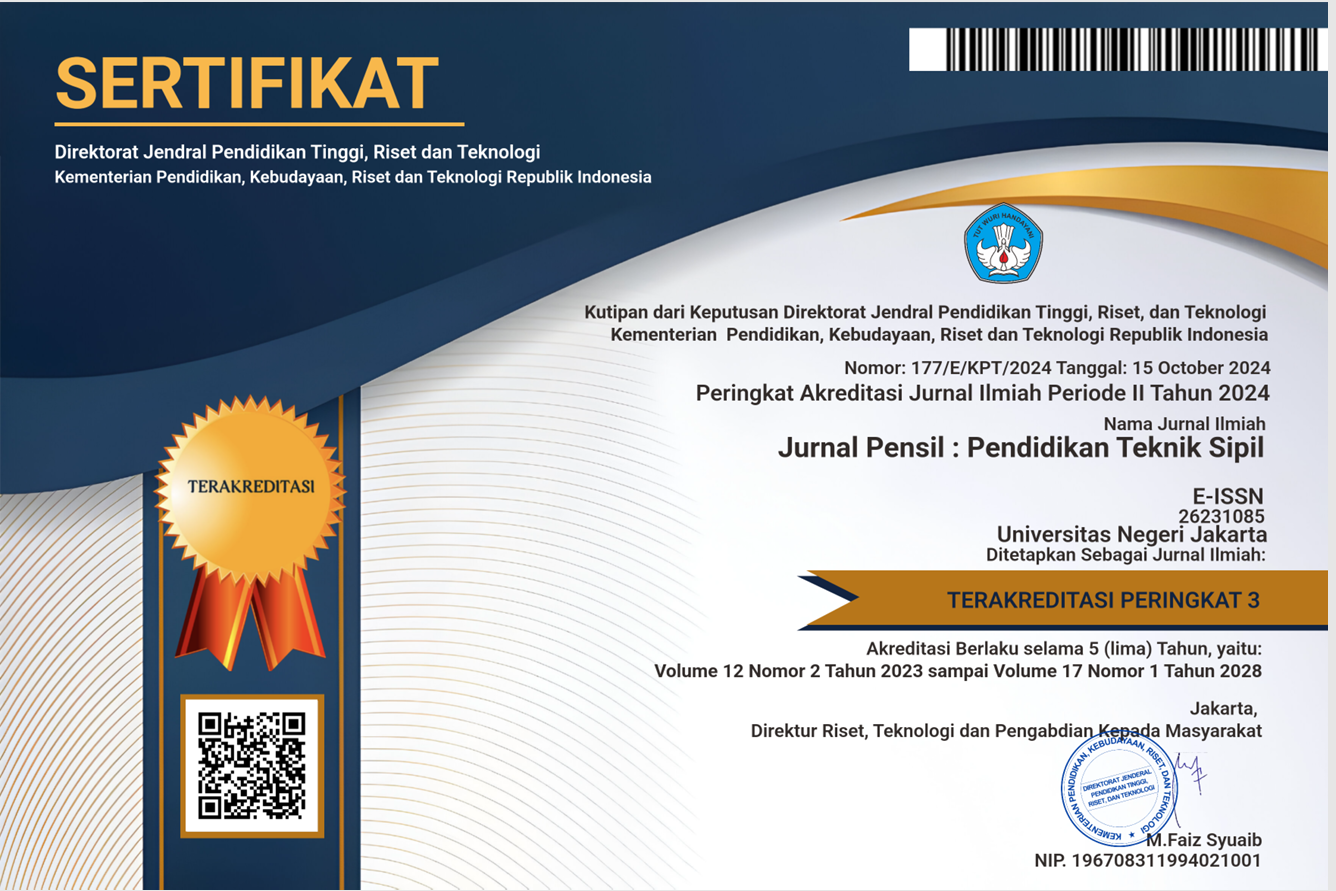EFFECT OF CANDLENUT SHELL ASH AS A SAND SUBSTITUTION ON COMPRESSIVE STRENGH OF PAVING BLOCK
DOI:
https://doi.org/10.21009/jpensil.v12i2.34382Keywords:
Paving Block, Candlenut Shell Ash, XRF Testing, Compressive StrengthAbstract
Candlenut is a superior commodity with great opportunities. Processing of candlenut seeds produces candlenut shells which are hard with a calorific value of 4164 cal/g so can be used as fuel. Processing candlenut shells as fuel produces waste of ash and not been utilized optimally. In this research, candlenut shell ash was used as a new alternative in making paving blocks, namely to substitute sand by 13%, 18% and 25% by weight of sand. The method used to analyze the chemical content of candlenut shell ash through XRF testing and compressive strength testing with a Compression Testing Machine after 28 days of curing time. Based on the results of the XRF test, hazelnut shell ash has a CaO content of 93.3%, where CaO is the main ingredient for making cement. In addition, the results of the average compressive strength of paving blocks at 13% substitution of candlenut shell ash produced a compressive strength of 5.89 Mpa, 18% substitution of candlenut shell ash of 8.72 Mpa, and 25% substitution of candlenut shell ash of 11.07 Mpa. The results of the compressive strength of paving blocks with the substitution of hazelnut shell ash produced standard standard paving block strength of D quality.
References
Ayu, A. D., Iskandar, T., & Anggraini, S. P. A. (2019). Pra Rancang Bangun Pabrik Pupuk Biochar Dari Tandan Kosong Kelapa Sawit Dengan Kapasitas 11.000 Ton/Tahun Menggunakan Alat Utama Rotary Kiln. Jurnal Penelitian MahasiswaTeknik Sipil Dan Teknik Kimia, 3(2), 245–250.
Baharuddin, M. M. R. (2021). Pemanfaatan dan Konstribusi Kemiri (Aleurites Moluccana) Sebagai Komoditi HHBK Terhadap Pendapatan Petani Di Kecamatan Bontocani Kabupaten Bone, Sulawesi Selatan. Parennial, 17(1), 26–34.
Bema, E. S., Hamzah, F., & Zalfiatri, Y. (2021). Karakteristik Briket dari Arang Daun Kelapa Sawit dan Arang Cangkang Biji Karet dengan Perekat Tapioka. Jurnal Sagu, 20(1), 1. https://doi.org/10.31258/sagu.v20i1.7899
Cao, Y., Fan, Q., Azar, S. M., Alyousef, R., Yousif, S. T., Wakil, K., & ... (2020). Computational parameter identification of strongest influence on the shear resistance of reinforced concrete beams by fiber reinforcement polymer. Structures.
Citrasari, N. (2019). Paving block with product 1 material as a substitute of portland cement and landfill mining residue. In IOP Conference Series: Earth and Environmental Science (Vol. 245, Issue 1). https://doi.org/10.1088/1755-1315/245/1/012002
Damdelen, O. (2019). Influences of construction material type and water-cement ratio reduction on thermal transmittance of sustainable concrete mixes. Construction and Building Materials, 196, 345–353. https://doi.org/10.1016/j.conbuildmat.2018.11.133
Dedyerianto, D., Asmin, L. O., & Isa, L. (2022). Pengaruh Penambahan Agregat Ban Bekas dan Limbah Botol Kaca Terhadap Karakteristik dan Kuat Tekan Batako. Jurnal Multidisiplin Madani, 2(3), 1139–1150. https://doi.org/10.54259/mudima.v2i3.479
Diana, A. I. N. (2020). Effect of addition waste bottle and fly ash variation to compressive strength environmentally friendly paving block. In Journal of Physics: Conference Series (Vol. 1538, Issue 1). https://doi.org/10.1088/1742-6596/1538/1/012025
Do, T. M., Kang, G.-O., & Kim, Y. (2019). Development of a new cementless binder for controlled low strength material (CLSM) using entirely by-products. Construction and Building Materials, 206, 576–589. https://doi.org/10.1016/j.conbuildmat.2019.02.088
Fathurrahmaniah, F., Ewisahrani, E., & Nursa’ban, E. (2022). Potensi Arang Tempurung Kelapa Sebagai Adsorben Pemurnian Minyak Goreng Bekas. Jurnal Pendidikan Ilmu Pengetahuan Alam (JP-IPA), 3(1), 19–23. https://doi.org/10.56842/jp-ipa.v3i1.110
Giri, J. P. (2023). Variability in the Compressive Strength of Paving Blocks Using Waste Plastic. In Lecture Notes in Civil Engineering (Vol. 269, pp. 575–583). https://doi.org/10.1007/978-981-19-3371-4_49
Halim, I. H., & Sepriyanna, I. (2022). PENGARUH SERBUK BAN BEKAS SEBAGAI BAHAN TAMBAH PADA CPHMA DENGAN VARIASI SUHU PEMADATAN TERHADAP KARATERISTIK MARSHALL. Construction and Material Journal, 4(2), 83–89. https://doi.org/10.32722/cmj.v4i2.4593
Halin, H. (2018). PENGARUH KUALITAS PRODUK TERHADAP KEPUASAN PELANGGAN SEMEN BATURAJA DI PALEMBANG PADA PT SEMEN BATURAJA (PERSERO) Tbk. Jurnal Ecoment Global, 3(2), 79. https://doi.org/10.35908/jeg.v3i2.477
Hastuty, I. (2018). Comparison of compressive strength of paving block with a mixture of Sinabung ash and paving block with a mixture of lime. In IOP Conference Series: Materials Science and Engineering (Vol. 309, Issue 1). https://doi.org/10.1088/1757-899X/309/1/012011
Hendri Nofrianto, H. (2023). Analisis Mutu Paving Block Dengan Variasi Agregat Halus. Jurnal Teknologi Dan Vokasi, 1(1), 54–62.
Huang, G., Pudasainee, D., Gupta, R., & Liu, W. V. (2019). Hydration reaction and strength development of calcium sulfoaluminate cement-based mortar cured at cold temperatures. Construction and Building Materials, 224, 493–503. https://doi.org/10.1016/j.conbuildmat.2019.07.085
Indah Handayasari, G. P. (2018). Bahan Konstruksi Ramah Lingkungan Dengan Pemanfaatan Botol Plastik Kemasan Air Mineral Dan Limbah Kulit Kerang Hijau Sebagai Campuran Paving Block. Konstruksia, 25–30.
Standar Nasional Indonesia: Paving Block, (1996).
Jiang, X., Mu, S., Yang, Z., Tang, J., & Li, T. (2021). Effect of temperature on durability of cement-based material to physical sulfate attack. Construction and Building Materials, 266, 120936. https://doi.org/10.1016/j.conbuildmat.2020.120936
Kareem, M. A. (2023). Characteristics of interlocking paving blocks made with cashew leaf ash as partial replacement for cement. Materials Today: Proceedings. https://doi.org/10.1016/j.matpr.2023.04.294
Lathifah, T., Yuliani, N., & Wardhani, G. A. P. K. (2019). BENTONIT TERAKTIVASI ASAM SULFAT SEBAGAI ADSORBEN DALAM PEMURNIAN PELUMAS BEKAS. Jurnal Sains Natural, 9(1), 1. https://doi.org/10.31938/jsn.v9i1.170
Ma, B., Liu, X., Tan, H., Zhang, T., Mei, J., Qi, H., Jiang, W., & Zou, F. (2018). Utilization of pretreated fly ash to enhance the chloride binding capacity of cement-based material. Construction and Building Materials, 175, 726–734. https://doi.org/10.1016/j.conbuildmat.2018.04.178
Martina, N., Hasan, M. F. R., & Setiawan, Y. (2019). Pengaruh Serbuk Ban Bekas Sebagai Campuran Agregat Halus Pada Campuran Aspal Porous. Wahana Teknik Sipil: Jurnal Pengembangan Teknik Sipil, 24(2), 144. https://doi.org/10.32497/wahanats.v24i2.1731
Minanulloh, M. A. B., Cahyo, Y., & Ridwan, A. (2020). PENGARUH PENAMBAHAN ABU CANGKANG KEMIRI TERHADAP KUAT TEKAN BETON K-300. Jurnal Manajemen Teknologi & Teknik Sipil, 3(1), 12. https://doi.org/10.30737/jurmateks.v3i1.875
Mohammad, L. N., Elseifi, M., Cao, W., Raghavendra, A., & Ye, M. (2017). Evaluation of various hamburg wheel-Tracking devices and AASHTO T 324 specification for rutting testing of asphalt mixtures. Asphalt Paving Technology: Association of Asphalt Paving Technologists-Proceedings of the Technical Sessions, 86(0), 165–185. https://doi.org/10.1080/14680629.2017.1389092
Murat Ozocak, C. B. S. (2017). Comparison between the Strength Characteristics of Pozzolan Stabilized Lateritic Soil of Coconut Shell Husk Ash and Palm Kernel Shell Husk Ash Admixtures. American Research Journal of Civil and Structural Engineering. https://doi.org/10.21694/2577-5944.17004
Nath, S. K. (2020). Fly ash and zinc slag blended geopolymer: Immobilization of hazardous materials and development of paving blocks. Journal of Hazardous Materials, 387. https://doi.org/10.1016/j.jhazmat.2019.121673
Oktaviastuti, B., & Leliana, A. (2020). Pengaruh Bahan Tambah Serbuk Ban Bekas Pada Konstruksi Hotrolled Sheet-Wearing Course. Rekayasa: Jurnal Teknik Sipil, 5(1), 7. https://doi.org/10.53712/rjrs.v5i1.849
Rashad, A. M. (2018). Lightweight expanded clay aggregate as a building material – An overview. Construction and Building Materials, 170, 757–775. https://doi.org/10.1016/j.conbuildmat.2018.03.009
Ren, Q., Zeng, Z., Xie, M., & Jiang, Z. (2020). Cement-based composite with humidity adsorption and formaldehyde removal functions as an indoor wall material. Construction and Building Materials, 247, 118610. https://doi.org/10.1016/j.conbuildmat.2020.118610
Setiawan, P., Adhy, D. S., & Ahyar, M. R. (2021). Karakteristik Kuat Tekan Campuran Beton dengan tambahan Serat Tembaga dan Serbuk Besi. Pondasi, 26(2), 72. https://doi.org/10.30659/pondasi.v26i2.18638
Sharonova, O. M., Kirilets, V. M., Yumashev, V. V, Solovyov, L. A., & Anshits, A. G. (2019). Phase composition of high strength binding material based on fine microspherical high-calcium fly ash. Construction and Building Materials, 216, 525–530. https://doi.org/10.1016/j.conbuildmat.2019.04.201
Simanjuntak, J. O., Saragi, T. E., Sidabutar, R. A., Pasaribu, H., & Simbolon, R. P. (2021). BETON BERMUTU DAN RAMAH LINGKUNGAN DENGAN MEMANFAATKAN LIMBAH ABU BAN BEKAS. Jurnal Visi Eksakta, 2(2), 141–149. https://doi.org/10.51622/eksakta.v2i2.374
Soehartono, S. S., Sasmito, A., & Chasanah, U. (2022). ANALISIS POTENSI PENAMBAHAN SERAT BATANG PISANG SEBAGAI BAHAN PEMBUAT PLAFOND UNTUK MENUNJANG TATA RUANG INTERIOR. Pondasi, 27(1), 112. https://doi.org/10.30659/pondasi.v27i1.18062
Syafpoetri, N. A., Djauhari, Z., & Olivia, M. (2018). Karakteristik Mortar Dengan Campuran Abu Kerang Lokan Dalam Rendaman NaCl. Jurnal Rekayasa Sipil (JRS-Unand), 14(1), 63. https://doi.org/10.25077/jrs.14.1.63-72.2018
Vasić, M. V, Pezo, L. L., & Radojević, Z. (2020). Optimization of adobe clay bricks based on the raw material properties (mathematical analysis). Construction and Building Materials, 244, 118342. https://doi.org/10.1016/j.conbuildmat.2020.118342
Yanette, Y., Ing, T. L., & Haris, S. (2019). Evaluasi Karakteristik Agregat untuk Dipergunakan Sebagai Lapis Pondasi Berbutir. Jurnal Teknik Sipil, 6(2), 151–164. https://doi.org/10.28932/jts.v6i2.1333
Yang, D., Zhao, J., Ahmad, W., Amin, M. N., Aslam, F., Khan, K., & Ahmad, A. (2022). Potential use of waste eggshells in cement-based materials: A bibliographic analysis and review of the material properties. Construction and Building Materials, 344, 128143. https://doi.org/10.1016/j.conbuildmat.2022.128143
Yusuf, Y., Putri, A. D., & Aziz, H. (2021). PENGARUH CLAY CONTENT PADA BATU KAPUR DI AREA BUKIT KARANG PUTIH INDARUNG SEBAGAI MATERIAL TAMBAHAN TERHADAP KUALITAS SEMEN PORTLAND KOMPOSIT. Jurnal Zarah, 9(2), 89–96. https://doi.org/10.31629/zarah.v9i2.3129
Zhang, J. P., Liu, L. M., Li, Q. H., Peng, W., Zhang, F. T., Cao, J. Z., & Wang, H. (2019). Development of cement-based self-stress composite grouting material for reinforcing rock mass and engineering application. Construction and Building Materials, 201, 314–327. https://doi.org/10.1016/j.conbuildmat.2018.12.143











.png)
.png)
1.png)

